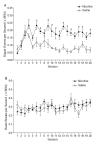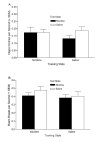Nicotine does not produce state-dependent effects on learning in a Pavlovian appetitive goal tracking task with rats
- PMID: 17129619
- PMCID: PMC1931617
- DOI: 10.1016/j.bbr.2006.10.026
Nicotine does not produce state-dependent effects on learning in a Pavlovian appetitive goal tracking task with rats
Abstract
Past research has shown that when rats received 0.4mg base/kg nicotine paired reliably with intermittent sucrose delivery that anticipatory sucrose-seeking behavior (i.e., goal tracking) was differentially displayed in the nicotine state relative to intermixed saline sessions in which no sucrose was delivered. The present research extended this observation to a lower dose of nicotine (i.e., 0.2mg base/kg) and tested a state-dependent learning account of differential conditioned responding. According to this account, the increase in goal tracking on nicotine sessions reflects a chamber-sucrose association that is only recalled when in the nicotine state. We used a 2x2 factorial design in which rats received sucrose deliveries in one drug state (nicotine or saline) and were then tested in the same state (Nic-->Nic or Sal-->Sal) or a different state (Nic-->Sal or Sal-->Nic) after acquiring the conditioned response. A state-dependency account predicts disruption in conditioned goal tracking for rats that receive a shift in drug state on the test day. This disruption did not occur suggesting that differential control of conditioned responding by nicotine is more likely due to a direct excitatory association between the interoceptive cueing effects of nicotine and the appetitive qualities of sucrose.
Figures




Similar articles
-
Interoceptive Pavlovian conditioning with nicotine as the conditional stimulus varies as a function of the number of conditioning trials and unpaired sucrose deliveries.Behav Pharmacol. 2006 Mar;17(2):161-72. doi: 10.1097/01.fbp.0000197456.63150.cd. Behav Pharmacol. 2006. PMID: 16495724
-
Exploring the interoceptive stimulus effects of nicotine and varenicline.Pharmacol Biochem Behav. 2019 Jun;181:9-16. doi: 10.1016/j.pbb.2019.04.001. Epub 2019 Apr 4. Pharmacol Biochem Behav. 2019. PMID: 30954637 Free PMC article.
-
Behavioral and neuropharmacological characterization of nicotine as a conditional stimulus.Eur J Pharmacol. 2007 Apr 30;561(1-3):91-104. doi: 10.1016/j.ejphar.2007.01.046. Epub 2007 Feb 1. Eur J Pharmacol. 2007. PMID: 17343849 Free PMC article.
-
Disentangling the nature of the nicotine stimulus.Behav Processes. 2012 May;90(1):28-33. doi: 10.1016/j.beproc.2011.10.020. Epub 2011 Nov 24. Behav Processes. 2012. PMID: 22119845 Free PMC article. Review.
-
Critical role of peripheral sensory systems in mediating the neural effects of nicotine following its acute and repeated exposure.Rev Neurosci. 2014;25(2):207-21. doi: 10.1515/revneuro-2013-0067. Rev Neurosci. 2014. PMID: 24535300 Free PMC article. Review.
Cited by
-
The inside story: Interoceptive Pavlovian conditioning with the nicotine stimulus.J Exp Psychol Anim Learn Cogn. 2025 Apr;51(2):61-72. doi: 10.1037/xan0000393. J Exp Psychol Anim Learn Cogn. 2025. PMID: 40193515 Review.
-
Conditioned response evoked by nicotine conditioned stimulus preferentially induces c-Fos expression in medial regions of caudate-putamen.Neuropsychopharmacology. 2012 Mar;37(4):876-84. doi: 10.1038/npp.2011.263. Epub 2011 Nov 2. Neuropsychopharmacology. 2012. PMID: 22048468 Free PMC article.
-
The interoceptive Pavlovian stimulus effects of caffeine.Pharmacol Biochem Behav. 2007 Apr;86(4):838-46. doi: 10.1016/j.pbb.2007.03.013. Epub 2007 Apr 3. Pharmacol Biochem Behav. 2007. PMID: 17477964 Free PMC article.
-
Nicotine enhances context learning but not context-shock associative learning.Behav Neurosci. 2008 Oct;122(5):1158-65. doi: 10.1037/a0012807. Behav Neurosci. 2008. PMID: 18823171 Free PMC article.
-
Nicotine-evoked conditioned responding is dependent on concentration of sucrose unconditioned stimulus.Behav Processes. 2009 May;81(1):136-9. doi: 10.1016/j.beproc.2009.01.002. Epub 2009 Jan 17. Behav Processes. 2009. PMID: 19429207 Free PMC article.
References
-
- Alessi SM, Roll JM, Reilly MP, Johanson C-E. Establishment of a diazepam preference in human volunteers following differential-conditioning history of placebo versus diazepam choice. Exp Clin Psychopharmacol. 2002;10:77–83. - PubMed
-
- Berger B, Stein L. Asymmetrical dissociation of learning between scopolamine and Wy4036, a new benzodiazepine tranquilizer. Psychopharmacologia. 1964;14:351–58. - PubMed
-
- Besheer J, Bevins RA. Acetylcholine: II. Nicotinic receptors. In: Riedel G, Platt B, editors. Memories are Made of These: From Messenger to Molecules. Texas: Landes Bioscience; 2004. pp. 113–24.
-
- Besheer J, Palmatier MI, Metschke DM, Bevins RA. Nicotine as a signal for the presence or absence of sucrose reward: A Pavlovian drug appetitive conditioning preparation in rats. Psychopharmacology. 2004;172:108–17. - PubMed
-
- Bevins RA, McPhee JE, Rauhut AS, Ayres JJB. Converging evidence for one-trial context fear conditioning with an immediate shock: Importance of shock potency. J Exp Psychol Anim Behav Process. 1997;23:312–24. - PubMed
Publication types
MeSH terms
Substances
Grants and funding
LinkOut - more resources
Full Text Sources
Miscellaneous

